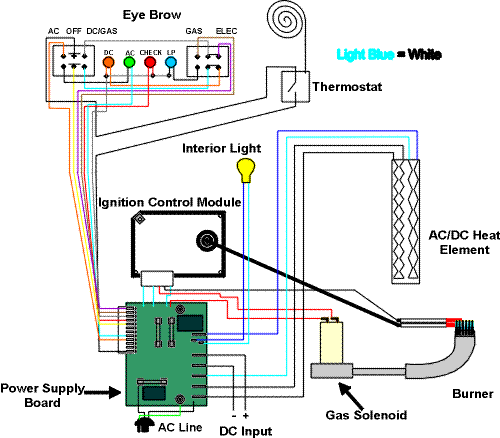Dave's Place
Norcold Electronics (838 and 8310)
Before attempting any repairs or testing, check out the gas safety and electrical safety pages.
The 838 and 8310 were the first electronically controlled ammonia refrigerators put out by Norcold. They were manufactured between 1983 and 1986. EG2 and EG3 following the model number indicated whether the refrigerator was two way (120 volt and gas) or three way (120 volt, 12 volt, and gas).

There were two recalls on the electronics of these models, the last of which removed 120 volt from passing through the eyebrow and considerably changed the wiring as it pertained to120 volt. The recalls came about because of a potential fire hazard. Our discussion will only involve 838 and 8310 models with the last recall. You can tell if you have the latest recall by looking at the eyebrow. See below.
The eyebrow that is a part of the last recall has two brown, non-functional buttons to identify it. If you have one or no buttons, you don't have the last recall. The recall is free, and you should contact a Norcold service center about getting it.

This graphic represents the wiring of the 838 and 8310 three way models. The two way models don't have the components necessary for DC (12 volt) heat. At first glance it might seem a little daunting, but the graphic shows how all the parts come together to form the electronic system. The individual components will be dealt with in more detail separately. As electronics go, this system is relatively simple.
The interior light circuit in the graphic is a simplification. This circuit also contains a door light switch, a high humidity switch, and a very low wattage high humidity heat element, which is located behind the front panel dividing the freezer and lower box of the refrigerator.
Operation
The user selects a heat source to use by pushing buttons on the eyebrow at
the top of the refrigerator and sets the thermostat. If the contacts in the thermostat
are closed, the eyebrow sends12 volt (+) to the Power Supply Board at
the appropriate terminal, "telling" it to turn on the selected heat source. If AC or DC are selected,
the Power Supply Board provides voltage directly to the appropriate wires of the combination
heat element. If Gas is selected, the Power Supply Board sends 12 volt
to the Ignition Control Module which then opens the gas solenoid valve
and lights the burner. When the thermostat is satisfied and its contacts open, the selected
heat source is turned off, including gas. Unlike manual refrigerators which have a high
and low gas flame, the burner on these models is shut down and relit as necessary.
If your burner lights and the refrigerator doesn't cool well on propane (but does on AC), you need to go back to the basics of gas heat. See the burner and orifice page for help.
RV Refrigerator Home
This RV refridgerator information was originally located on rvmobile.comRV Mobile Inc. 11715 HWY 99, Everett, WA 98204
The owner of RV Mobile Inc. apparently suffered a heart attack and the original website was shut down.
It has been reposted here to preserve this wealth of information RV refridgerator information.